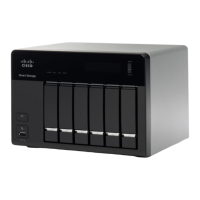Managing the System
Network Shares
Cisco Small Business NSS300 Series Smart Storage Administration Guide 138
3
STEP 3 From the Source ISO Image File field, select an ISO image file on the NAS.
STEP 4 Click Next and the image file will be mounted as a share folder on the NAS.
STEP 5 In the ISO Share Folder Settings window, enter the following parameters:
• Folder Name—Enter the folder name.
• Hide Folder—Choose Yes to hide the folder. Default is No.
• Description—Enter a description for the folder.
STEP 6 Click Next. The Privilege window opens.
STEP 7 Specify the user access rights to the share folder:
• Grant read-only access right for administrators only—Read only access
for administrators only.
• By User—Access rights to share folder by user.
• By User Group—Access rights to share folder by user group.
STEP 8 Configure the Guest Access Right:
• Deny Access—Deny guest access.
• Read only—Allow read only access for guests.
STEP 9 Click Next.
STEP 10 Confirm the settings and click Next.
STEP 11 The new share folder is created successfully. Click Finish.
After mounting the image file, you can specify the access rights of the users using
different network protocols such as SMB, AFP, NFS, and WebDAV by clicking the
icons in the Action column from the Share Folders tab.
The NAS supports mounting ISO image files using Web File Manager, see Mount
ISO Shares, page 171.
Quota
From the Network Shares > Quota window, you can enable the quota settings for
all the users and specify the quota size they are allowed to use on each disk
volume of the NAS. This function is disabled by default.

